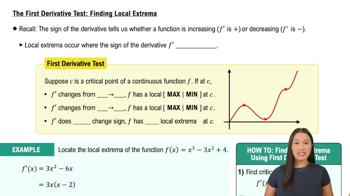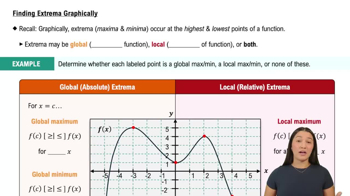Table of contents
- 0. Functions7h 52m
- Introduction to Functions16m
- Piecewise Functions10m
- Properties of Functions9m
- Common Functions1h 8m
- Transformations5m
- Combining Functions27m
- Exponent rules32m
- Exponential Functions28m
- Logarithmic Functions24m
- Properties of Logarithms34m
- Exponential & Logarithmic Equations35m
- Introduction to Trigonometric Functions38m
- Graphs of Trigonometric Functions44m
- Trigonometric Identities47m
- Inverse Trigonometric Functions48m
- 1. Limits and Continuity2h 2m
- 2. Intro to Derivatives1h 33m
- 3. Techniques of Differentiation3h 18m
- 4. Applications of Derivatives2h 38m
- 5. Graphical Applications of Derivatives6h 2m
- 6. Derivatives of Inverse, Exponential, & Logarithmic Functions2h 37m
- 7. Antiderivatives & Indefinite Integrals1h 26m
- 8. Definite Integrals4h 44m
- 9. Graphical Applications of Integrals2h 27m
- 10. Physics Applications of Integrals 2h 22m
5. Graphical Applications of Derivatives
Intro to Extrema
Problem 4.3.34
Textbook Question
Increasing and decreasing functions. Find the intervals on which f is increasing and the intervals on which it is decreasing.
f(x) = cos² x on [-π,π]
 Verified step by step guidance
Verified step by step guidance1
First, understand that to determine where the function f(x) = cos²(x) is increasing or decreasing, we need to find its derivative, f'(x).
Calculate the derivative of f(x) = cos²(x) using the chain rule. The derivative of cos²(x) is f'(x) = 2cos(x)(-sin(x)) = -2cos(x)sin(x).
Simplify the expression for the derivative: f'(x) = -sin(2x), using the double angle identity for sine.
Determine the critical points by setting the derivative equal to zero: -sin(2x) = 0. Solve for x to find the critical points within the interval [-π, π].
Analyze the sign of f'(x) = -sin(2x) in each interval determined by the critical points to identify where the function is increasing (f'(x) > 0) and where it is decreasing (f'(x) < 0).
 Verified video answer for a similar problem:
Verified video answer for a similar problem:This video solution was recommended by our tutors as helpful for the problem above
Video duration:
5mPlay a video:
Was this helpful?
Key Concepts
Here are the essential concepts you must grasp in order to answer the question correctly.
Derivative
The derivative of a function measures the rate at which the function's value changes as its input changes. For a function to be increasing, its derivative must be positive, while a negative derivative indicates that the function is decreasing. In this context, finding the derivative of f(x) = cos² x will help identify the intervals of increase and decrease.
Recommended video:

Derivatives
Critical Points
Critical points occur where the derivative of a function is zero or undefined. These points are essential for determining where a function changes from increasing to decreasing or vice versa. By analyzing the critical points of f(x) = cos² x within the interval [-π, π], we can establish the behavior of the function in those regions.
Recommended video:

Critical Points
First Derivative Test
The First Derivative Test is a method used to determine the nature of critical points by examining the sign of the derivative before and after each critical point. If the derivative changes from positive to negative at a critical point, the function has a local maximum; if it changes from negative to positive, it has a local minimum. This test will help us confirm the intervals where f(x) is increasing or decreasing.
Recommended video:

The First Derivative Test: Finding Local Extrema

 5:58m
5:58mWatch next
Master Finding Extrema Graphically with a bite sized video explanation from Callie
Start learning





